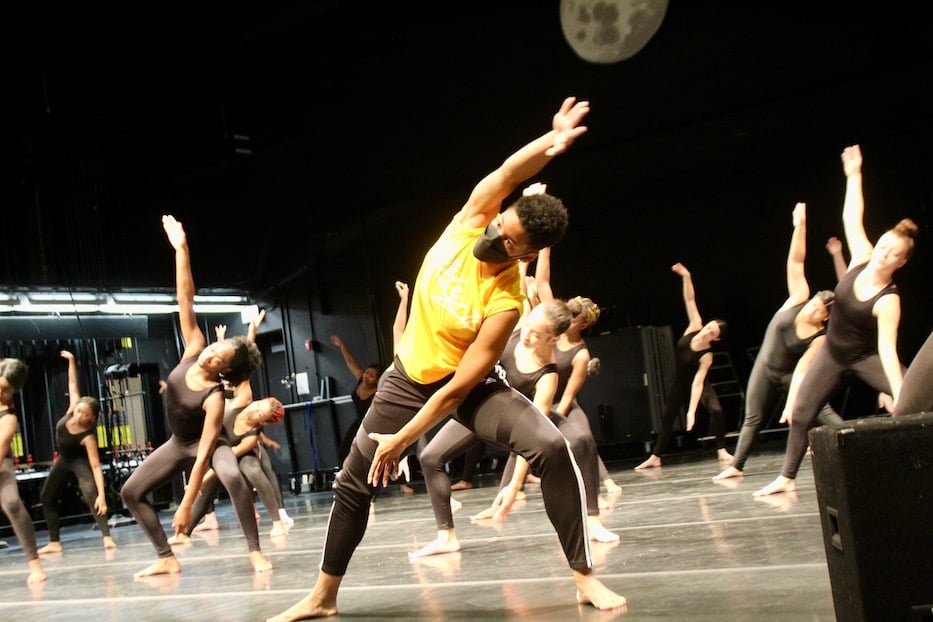
Ailey II dancer Maya Finman-Palmer, who is originally from Madison, Wisc. “When you guys dance, I want you to feel something," she said. Lucy Gellman Photos.
The class had just moved into second position when Maya Finman-Palmer went into a plié, bent forward, and let her muscles unspool. Her arms became squid-like, as if they had no bones in them at all. Her knees sank toward the stage. Kelsey Lu’s “Due West” filled the whole auditorium, the sound wrapping limbs and shoulders, slipping into crevices and cracks. Two dozen pairs of eyes followed Finman-Palmer as she moved.
“When you guys dance, I want you to feel something,” she said as all of them watched her.
Finman-Palmer is a dancer in Ailey II, the world-renowned, New York-based dance company that grew out of Alvin Ailey Repertory Ensemble almost five decades ago. On a recent Monday, she and fellow dancers Kali Oliver and Patrick Gamble brought their skill to Cooperative Arts & Humanities High School for a master class in dance for sophomores, juniors, and seniors. It followed a performance at the Shubert Theatre the night before; close to two dozen students attended.
At first, it was another second period class on a Monday morning. Over 90 minutes later, it had become a testament to the power of representation—and a snapshot of the bright and explosively creative future these young dancers have ahead of them.
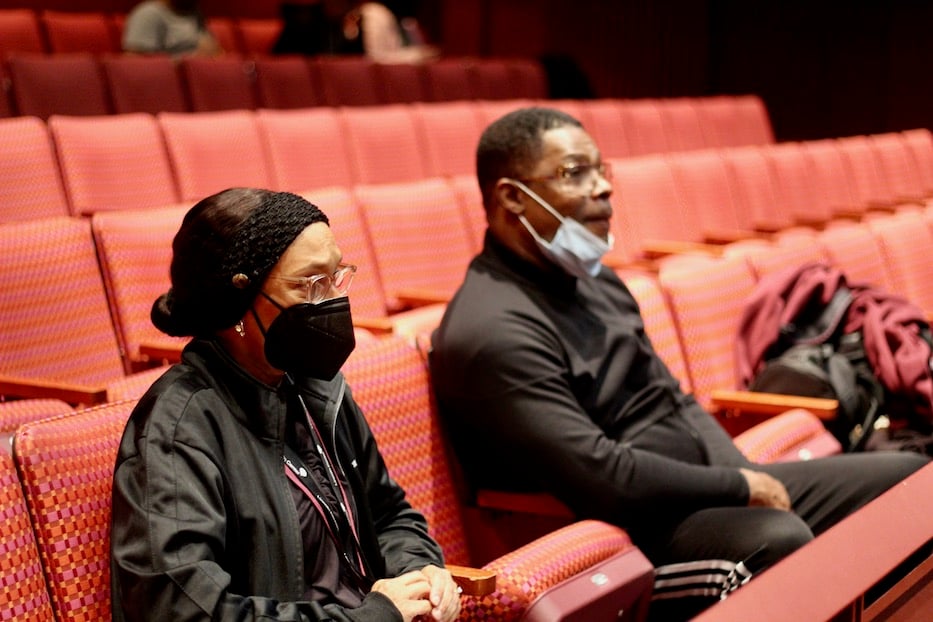
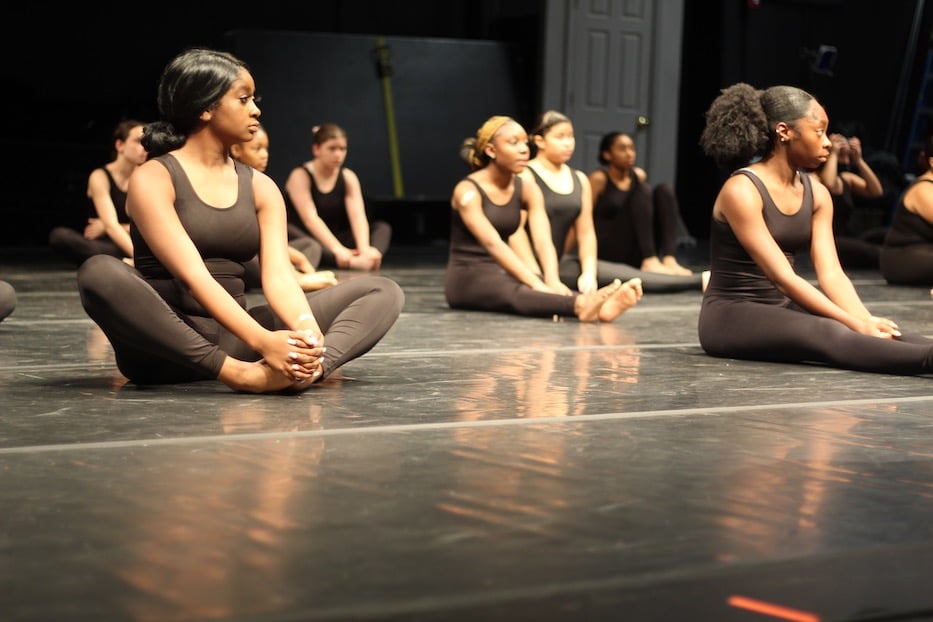
Top: teachers Christine Kershaw-Hobson and Stephen Hankey (teacher Lindsey Bauer was also there). Bottom: Students Jaya Mabry and Paris Whitaker. Lucy Gellman Photos.
“I think it’s a great example for the students to have this experience, because they see that what they’re learning transfers to everything,” said dance teacher Christine Kershaw-Hobson, once an Ailey dancer herself. “Once they learn that, I think their minds will be so open.”
From the beginning of the class, that learning was on full display. As Ailey II company members made their way onto the stage, they eased into warmups, introducing themselves by hometown and experience as they prepared to move. Less than 24 hours before, they had graced the Shubert’s stage, at turns light-footed and ethereal in numbers from “Revelations” and “Freedom Series” among others. Now, they seemed suddenly human again, smiling beneath their masks as they spoke about growing up in Queens, Ohio, and Wisconsin.
Oliver flipped on the sound, and the familiar beat and vocals of “Latch” welcomed tired-eyed students into the week. Around them, the auditorium slowly stirred to life, footfalls gently rising up to meet breath. A cardboard moon left over from an ill-fated performance of RENT hung suspended backstage, peering down curiously. On the downbeat, dancers began to move, first with a shake of their heads, then necks, then shoulders and knees. Arms, hips, and torsos flowed into the movement.
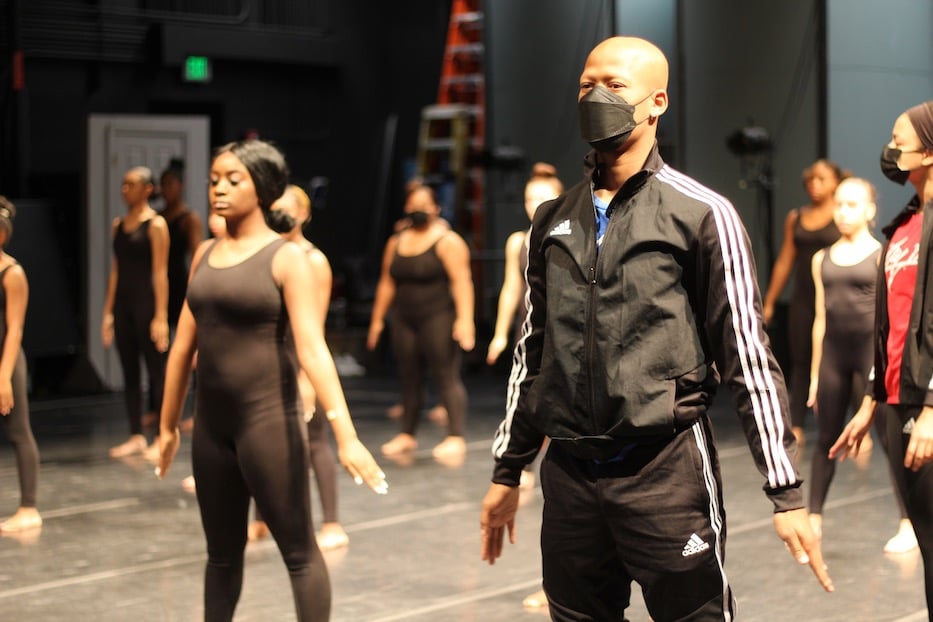
Ailey II dancer Patrick Gamble.
In the first row, students Jaya Mabry and Paris Whitaker sank into their bodies, as if they were sloughing off the weight of the past three years. At the front of the stage, “Latch” drifted into Jill Scott’s “Golden”—“You guys look great by the way!” chirped Oliver—and students shook it out before snapping back to attention. Counting them off, Oliver rolled down toward the stage, her back gentle as she doubled in on herself. Beneath the music, a listener could have heard a pin drop as students followed each motion.
It became a gradual lesson in fluid movement. To Clean Bandit’s “Rather Be,” Gamble counted students in on a series of stretches, the class graceful as they raised their arms toward the ceiling, bodies facing the sky and then just as quickly, extended back toward the stage. When they moved into pliés and relevés, they experimented with a bent limb here, a liberated hip there. By the time Sampha’s “Without” boomed over the group, they had become a sea of extended arms, spread fingers, swinging legs and steady feet that turned the stage into a new teaching ground.
It gives them a chance to expand the work they are learning in the classroom, Kershaw-Hobson said. When students begin dancing at Co-Op—whether they have taken lessons for years or are coming to it for the first time—teachers focus on the fundamentals of technique, from vocabulary and history to rigorous technical training. Only after they’ve learned the basics—and taken a survey of styles from around the globe—are they ready to get creative with their movement.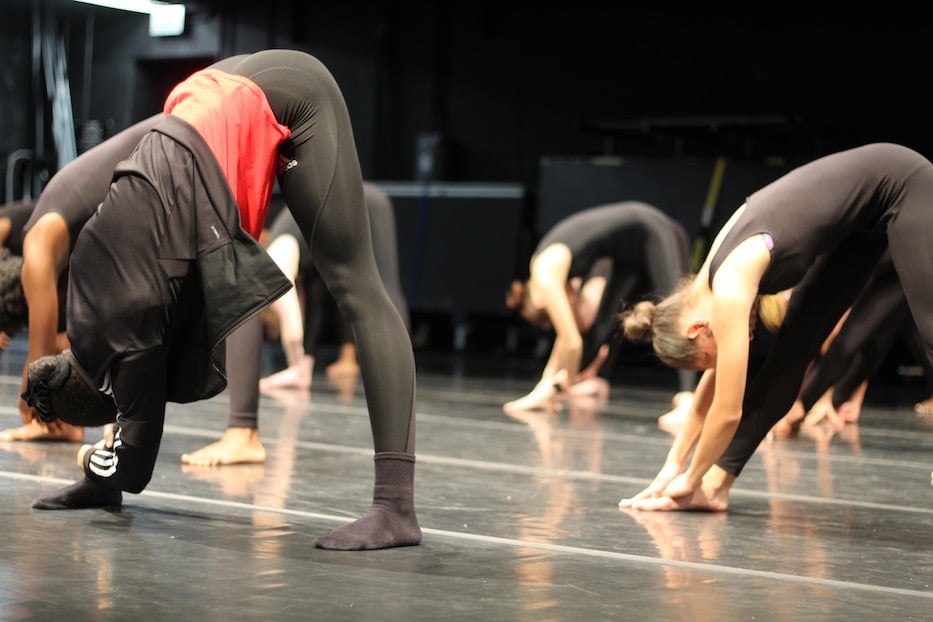
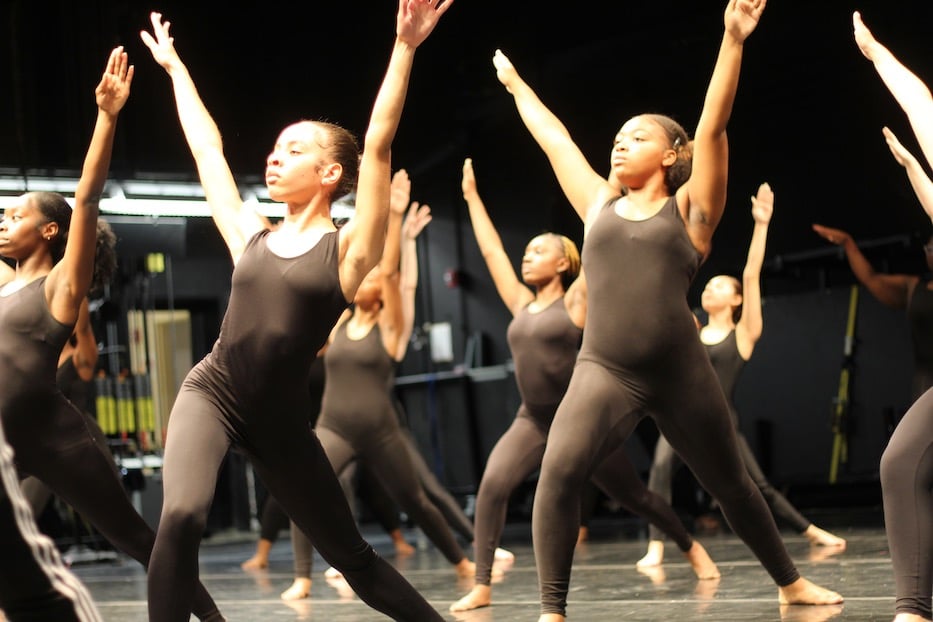
“I would like to do it all day if I could," said senior Trinity Wallace (with hair pulled into a bun in bottom photo).
That’s not new, she added: she and fellow faculty believe that students must understand the rules of dance before they treat them as porous or breakable. “Imagine if someone was up here who didn’t know how to spot,” she said. It would be a mess: dancers might go into a turn, and fall or stumble on the stage, disoriented by the movement. “Because they know their technique, look at the freedom and fluidity they’re able to achieve.”
Monday, that meeting of worlds—technical and creative, learned and possible and still new—was everywhere. As student went from leg lifts into chassés, Oliver encouraged them to feel the movement in their bodies, thinking about it as their feet soared across the stage. “Take a little travel!” she said, eyes crinkling at the edges above her mask. “Feel the wind on yourself!”
Around her, students built a new language, where chassés, pliés and all five ballet positions could live comfortably alongside circling hips, wiggling hands and arms, and legs that were suddenly free.
As “Due West” filled the space, that sense of transformation flitted through the group in real time. Finman-Palmer stood at the front, her bare feet spread at second position and flat on the stage. Lyrics rose over the space, and she sank towards the floor, then let everything in her body unlock at once. Her arms soared, making their way around her body. Her back, thighs, and hips became free. She lifted her carriage back towards the sky.
Then, she told members of the class, it was their turn to shine. She looked behind her, eyes soft, and encouraged students to let themselves move fluidly. At first, they seemed hesitant, dipping into the same second position that had been doing for years. Finman-Palmer kept moving. Then something clicked. Students relaxed, and began to feel the music in their chests, arms, legs and feet. Their bodies swayed and drifted to the lyrics, limbs fluid.
“What difference did you feel?” she asked after dancers had tried it behind her. There was a beat before anyone responded. Students had yet to learn a part of "Revelations" that the group had danced the night before. Then sophomore Alondra Rodriguez piped up.
“I felt more lively and free,” she said.
“I Felt Free”
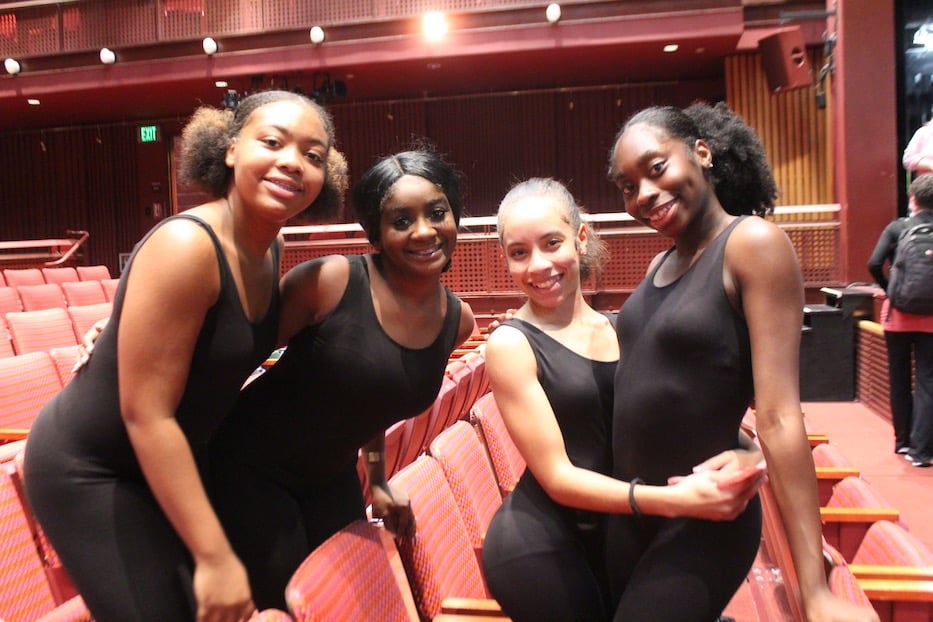
Sanbria Pettway, Jaya Mabry, Trinity Wallace and Paris Whitaker.
Throughout the morning, both students and teachers stressed the importance of representation in the school's dance curriculum and well beyond it. Trinity Wallace, a senior who has been dancing with Tia Russell Dance Studio for years, pointed to how differently she moved with Ailey II than she sometimes does in her own classes.
On stage, she had eased into the movements, at one point so comfortable that she had landed a forward jump, locked eyes with Oliver, and burst into a smile that turned into a quiet laugh. Off stage, she said, she was grateful for the reminder that dancers who look like her exist beyond the school’s walls.
“I felt like I could be myself,” she said. “I felt free. When it’s your people, you’re like, ‘Oh, you can do this. I can do this.’”
“I would like to do it all day if I could,” she added. Both she and Whitaker, who have been dancing together for years, said it helps them ease the stress that they feel with homework, extracurriculars, home life and college applications, an entire form of stress within themselves.
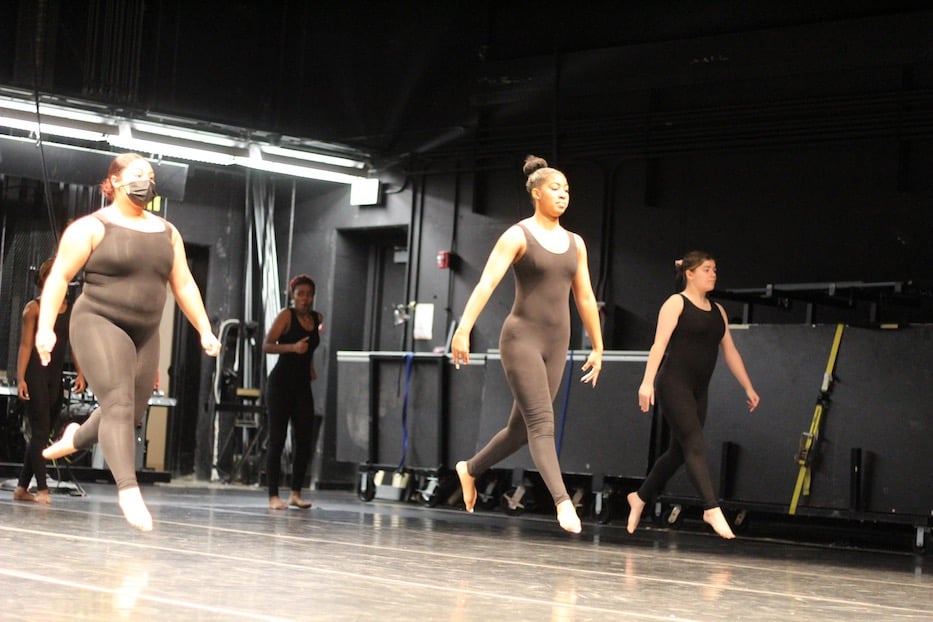
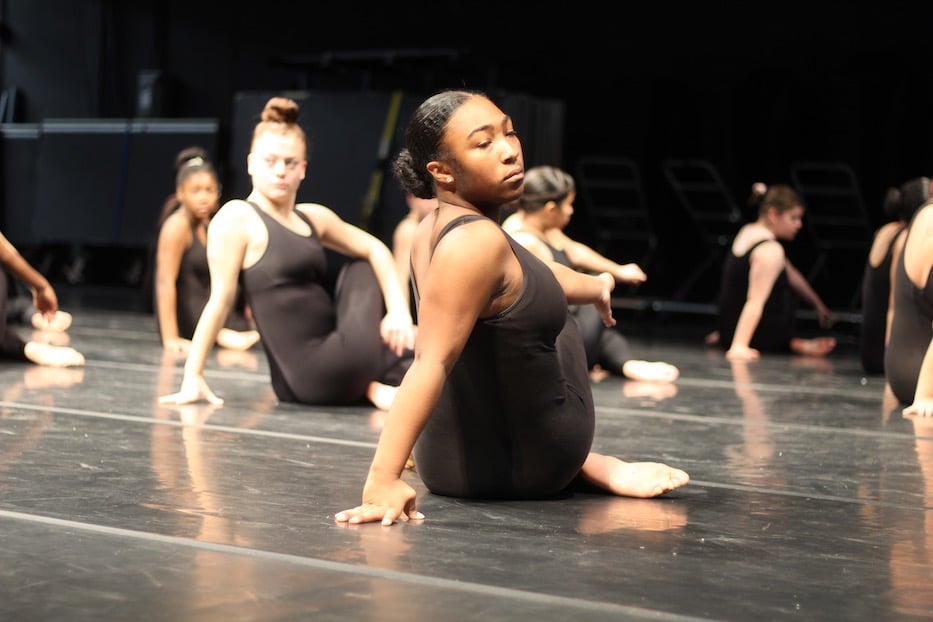
Mabry, who began dancing when she arrived at Co-Op, said that she both “felt represented” and was grateful for the chance to improvise, which she doesn’t always get in her classes. So did junior Sanbria Pettway, who noted how good the class felt from start to finish. This is not her first experience with Ailey II, she added: her brother Bradyn danced with the company in a summer intensive, and is now studying dance at Pace University in New York.
Their teachers want that for them too. Watching the group from the back of the auditorium, Kershaw-Hobson noted how formative it is for students to have instruction from professional dancers—especially those who look like them, and may reflect their lived experience. It reminds them that they can practice their craft in the real world.
That was also true for Kelly Wuzzardo, director of education and engagement at the Shubert. With Janie Alexander, the production and technical education manager at the school, Wuzzardo is responsible for the theater’s close teaching relationship with the school, which she’s grown for almost two decades. So when she learned that Ailey II would be coming to the Shubert in October, she worked to bring dancers in to work with students.
Sitting in an office next to the auditorium, she described it as a push to give New Haven students a snapshot of what their life could be after high school.
“This could be their life someday,” she said. “Whenever we have the opportunity to do more, we do it.”
For more from the master class, check out videos on the Arts Council’s Facebook page.